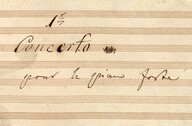



Atut - Autograph of first Tutti
| Date: | 1833 |
| Title: | 1r Concerto |
| Dedication: | None |
Atut comprises only bars 1-138. However, the "Solo" indication after the last written bar and the mark Chopin used to identify points of contact of fragments written in various places prove that the autograph is not unfinished, but that it complements a different source (currently lost). As Atut served as Stichvorlage for FE, that source must have been a complete Stichvorlage for that edition, most probably the lost autograph of the solo part of the entire Concerto ([A]) in the form of a separate manuscript or as part of the lost handwritten sheet music of the whole piece ([P])*.
Atut was written in haste, which is proved by a significant number of inaccuracies as well as by graphic features – characteristic hooks next to note stems and other vertical lines, carelessly written accolades, clefs and key signature. An unintentional trace of a hastily moved quill misled the engraver of FE in bar 39.
Examples of inaccurate notation:
- omitted accidentals next to bottom notes of octaves, e.g. in bar 4, 12, 36 and 38, 41 and 44, 79 and 83, 91, 94;
- other patent omissions of accidentals, e.g. in bar 36 and 128;
- vague rhythmic notation in bar 110.
Atut was most probably developed due to the changes Chopin introduced to this movement between the performance of the piece in October 1830 in Warsaw and its publication in 1833 (perhaps under the influence of F. Kalkbrenner, who suggested him to remove a fragment from the Concerto's sheet music; Chopin must have received that piece of advice at the turn of October and November 1831**). Some minor changes were introduced already after Atut had been written, in the proofreading of FE – examples are given in the characterization of that edition.
* More on the type of lost sources – see the characterization of A in the 1st mov. of the Concerto in F Minor, Op. 21.
** Chopin came to Paris on 5 October, and on 27 November his sister Ludwika already reports on Elsner's reaction to Kalkbrenner's suggestion described previously by Chopin.
| Original in: | Österreichische Nationalbibliothek, Vienna |
| Shelf-mark: | Mus. Hs. 41.069 |

